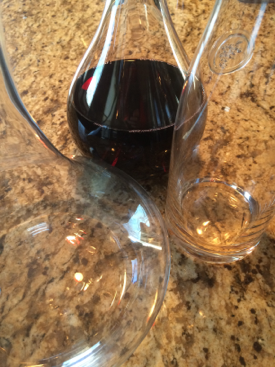
Decant Your Young Red Wines
For most wine consumers holding wine means buying it on a Tuesday and drinking it on a Saturday. For the next rarer wine consumer that likes to keep a healthy stash of a dozen bottles or so on hand will most likely never hold a single bottle for more than 12 months. Rarer still are those who lay down wine with a strategy of drinking a portion of their cache over the course of years.
What does this have to do with decanting wine? I’m glad you asked. I point out the typical buying and consuming patterns only to illustrate that most wine is purchased and drunk shortly after it is released. The same goes for dining out – most restaurant wine lists are comprised of current releases. Restaurants and wine bars should surly decant more frequently than observed by this writer. Many red wines, especially dense and concentrated wines like Cabernet, many Nebbiolo, and Zinfandel, as well as wines with a healthy dose of acidity such as Sangiovese and Tempranillo among others are happiest with a bit of a wake-up. Decanting provides the perfect wake-up.
Decanting is seen by many as one of those stodgy old traditions that wine snobs love to enact. Don’t let this detour you. The kind of decanting that I most fervently advocate is a simplistic procedure with no fanfare and no rituals.
Your youthful red will show you all of its depth and clever nuances once it has had a proper breathing. To achieve this all you need is a glass decanter capable of holding a bottle of wine with a bit of room to spare and the wine opener of your choice. Open the wine and splash it into the decanter at a 45 degree angle. If you are feeling confident slow the flow as you near the end and look for sediment. You are not likely to encounter any debris but if you do you should choose to leave as much behind in the bottle as possible.
Choosing a Decanter
If you don’t have a decanter you don’t need to wait for a holiday or submit a gift registry. A quick look at amazon.com revealed about 100 glass decanters sold at $25 and less. You can click your mouse and have a decanter in your hands by the weekend.
If you need just one decanter choose one with a capacity of one-liter as the typical wine bottle offers three-quarters of a liter. When you get your decanting groove on you will find yourself wanting a decanter with even a larger capacity and different shapes as well. A tall and slender decanter will slowly aerate your wine while a wider version that offers more surface area for the wine will more assertively aerate. Common sense, right?
Decanting Older Wines
Decanting older wines can be tricky; this is where the rituals come in. You want to decant an older wine when you are reasonably sure that the wine will benefit from an accelerated aeration and you want to separate the wine from the sediment. If you are ready to pull an older wine out of your collection then spontaneity is probably not an issue, This is a good thing as you are going to want to stand the bottle up in a quiet place for two days. This should be sufficient time to allow the fine sediment a chance to settle.
Further, you may want to question the wisdom of decanting. If you are uncertain of the wine’s maturation you will want to carefully pour a small sample after opening and prior to decanting. If after 10 minutes the wine is showing signs of advanced maturation you will want to skip decanting the wine. Instead ready the glasses to be shared and pour a generous portion while never allowing the wine bottle to become fully vertical. In this way you will keep as much of the sediment as possible at the bottom of the bottle.
If the wine is still full for vigor proceed with decanting. I prefer to fully eliminate the foil, which fights against all sommelier training but I’m at home and I want to make things as easy as possible. Find a light source: a candle, a small flashlight, a mobile phone or something else to assist you in spotting the sediment. Slowly pour the wine into the decanter in one motion – no stopping and starting. As you reach the end of the bottle you will likely encounter a bit of sediment. It’s up to you to spot the cut-off point. In the end you’re balancing the desire to get every drop and the desire to have glasses of wine free of sediment.
If you have managed this you have accomplished the tricky type of decanting and are now some sort of wine guru. While this accomplishment doesn’t come with a t-shirt you should feel a warm glow of victory nonetheless.
If I haven’t convinced you to get a decanter please go to the top of the page and read again. For the rest of you, let’s have a drink.
